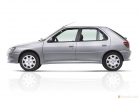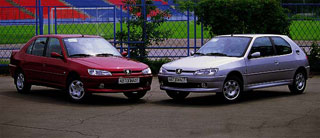PEUGEOT 306 Test drive 5 doors 1997 - 2001 hatchback
Second-Hand Peugeot 307 from $ 13,000

PEUGEOT 307 was replaced by the 306th model in 2001. The 3- and 5-door hatchbacks were the first to see the light, and a year later, a station wagon 307 SW appeared. The design of the 307th compared to the predecessor was a real revolution: the car turned out not only beautiful, but also incredibly spacious.
At the same time, the price was quite humane, the level of equipment is high, and the sales of Peugeot 307 went with a bang. True, at first the car suffered from a number of childhood diseases, and as a result, many buyers considered themselves deceived in their expectations.
Engines
The hatchbacks were equipped with three gasoline and three diesel engines. The smallest gasoline (1.4 liters, 75 hp) proved to be well on the 206th, but for a heavier 307th model it is weak and can satisfy only very calm drivers. But the 1.6-liter engine developing 110 hp is just right. For fans of the energetic driving style, there is a 2-liter 137-horsepower unit that makes the Peugeot 307 a fairly fast machine. In general, there are no complaints about engines, they work reliably. Oil replacement is provided after 30 thousand km under normal operating conditions and after 20 thousand km in severe. In our conditions, especially if you drive around the city a lot, it is better to serve the engine in 20 thousand km. The replacement of the timing belt is provided after 90 thousand km ($ 290). Of the childhood diseases met on the first years of production, it should be noted a difficult to launch the motor at low temperatures. This is eliminated by the reprogramming of the engine control system, and if you are faced with such a problem, contact the dealer. And one more nuance: in the frost, the motor needs to be started by squeezing the accelerator pedal for about a third. In the first batches of engines sometimes failed, the ignition system, but this was eliminated under warranty.
There were also three diesel engines: 1.4 liters (68 hp) and 2 l (90 and 110 hp). All engines with turbocharging and the Common Rail system. A small diesel is a tribute to the ecology fashion, and the car rides very slowly with it. Such modifications were not supplied to us. Cars with a 2-liter diesel engine are older, especially with 110-horsepower. Like all engines with the Common Rail system, these motors do not complain of poor diesel fuel, otherwise they work reliably. Oil replacement is required after 20 thousand km for normal operating conditions, after 15 thousand km for difficult ones. It is better to change the oil after 15 thousand km. The replacement of the timing belt is provided after 120 thousand km ($ 290).
A feature of Peugeot engines is a tense thermal regime, which is why specific requirements are presented to the clock. Therefore, it is better to use the Total oil recommended by the manufacturer. The replacement of the coolant should be carried out once every 2 years or after 120 thousand km of run.
Transmission
Cars were equipped with mechanical 5-speed gearboxes and 4-band AL4 machines. Mechanical traditionally for Peugeot have stretched gear rates to increase efficiency, they work reliably, but differ in fuzzy gear shifts. AL4 are a new generation of adaptive transmission and have convenient settings. True, it is believed that their guaranteed resource is approximately 150 thousand km, which is less than the German ZF, so the car with an automatic machine and a mileage of more than 100 thousand km should buy, only carefully weighing everything. Both mechanical and automatic checkpoints do not require maintenance throughout the entire service life, but in fact it is better to change the oil every 60 thousand km in them, using only the original. This is especially true for machine guns.
Some machines noted the rapid detonation of the clutch, but the cause of these faults was most likely illiterate operation of cars by the owners themselves. There are no more comments on the transmission, the crows during normal operation serve for a long time, the main thing is to monitor the condition of the anthers.
Suspension and steering
The suspension is simple: in front of the racks McPherson, behind a semi-dependent suspension with an N-shaped beam. On the 307th, the French abandoned traditional torsiones in the rear suspension. As a result, the car lost a little in smoothness, but won in simplicity and reliability, because in this design there is practically nothing to break. In front of about once every 40 thousand km of replacement requires a stabilizer rack ($ 45), ball supports and silent blocks are kept up to 100 thousand km. Balls change along with levers ($ 170), silent blocks are extended separately. The shock absorbers in PEUGEOT of their own production are of high quality and large (often more than 100 thousand km) resource. At the same time, they are inexpensive: $ 90 per front and 85 for the rear. So, if it is necessary to replace shock absorbers, it is better to put the original ones - the benefit of such a solution is obvious. In the first batches of cars delivered to our market, the front suspension began to knock on irregularities. This is eliminated by the installation of special springs for the springs. Subsequent parties of cars for Russia were equipped with such spacers at the factory. If you have acquired a European version and faced this problem, contact the dealer, and it will be eliminated. In the machines of the first issues in rare cases, the rapid wear of the stabilizer bushings was noted, which is easy to fixed.
The steering with a hydraulic wrap operates reliably, it is periodically required to replace the tips ($ 45) and steering rods ($ 60).
Brake system
Disc brakes were installed on the front and behind the car. All cars were equipped with ABS, many were additionally equipped with a stabilization system. The brake discs are replaced once every three pads of the pads, the brake fluid changes once a year or after 60 thousand km.
Body and electrical equipment
The body of Peugeot 307 likes many. The car is spacious, high landing and a large glazing area provide good overview. And the station wagon 307 SW can be additionally equipped with seats of the third row, making it 7-seater. The back of the spacious body is that when planting and landing from the front seats, people even risk staining the pants on a wide and quickly polluted threshold. In addition, the finishing materials of the cabin of low quality, and on the cars of the first years of production, the entire interior creaks. This is especially manifested on the station wagons. True, recently the plant has held some measures to eliminate these shortcomings. And for the first creaky salons, factory sets are offered to fight the creaks. The plant sent the dealers the sets of foam and felt gaskets and the technology of the body pasting with these materials. You should also very carefully park near the curbs and snowdrifts, because the radiator hangs on a weak bracket, which is easy to damage.
The electrical equipment of the Peugeot 307 also evokes conflicting feelings. The transition to multiplex tires instead of conventional wires is dictated by an increase in the number of electric components and in itself is a progressive and logical solution. On the 307th, you can configure the lighting, the mirror folding algorithm and so on, it has a rain sensor and other service devices. At the same time, everything is quite compact, with a minimum amount of electrical wiring, which theoretically long to increase the reliability of the electrical system. But everything turned out to be not so simple. Although the quality of the connectors and other electric components on the 307th became much better than that of the predecessor, problems with electrical equipment on the machines of the first years of production poured one after another. The ignition locks refused, because of which the motor could stall at the most inopportune moment, after the launch the starter could not turn off and, of course, fell apart. There were even several cases of ignition locks. Sometimes the steering wheel switches refused, on many machines the leature of headlights and rear lights were noted.
Often the back door locks broke, which also changed according to warranty. Due to the imperfection of the software, door-locks were out of order, indicators ceased to work, and other small troubles occurred. Sometimes an electronic block BSI, which controls all this farm, was out of order. By the way, even an inept replacement of the battery or its discharge could disable him. The fact is that the battery can be turned off no earlier than two minutes after the ignition is turned off, and after installing the battery, at least two minutes the ignition cannot be turned on. Otherwise, the block can forget everything, or even demand a replacement. The same thing could happen when the battery was discharged, and if you recall the problem with the winter start, then this option is quite likely. Naturally, they fought with childhood diseases, defective details were changed, their design was finalized, software was improved, and in several years the problems were solved.
Maintenance
For Peugeot, two types of then are provided: A and S. The first of them are small, consisting of oil replacement, filters and conducting control operations. The second, large, implies a more detailed study of the condition of the car and the conduct of adjustment. Small and large are carried out alternately, the frequency is said above. They cost both gasoline and diesel machines $ 140 and $ 250.
conclusions
If you intend to purchase Peugeot 307, you need to clearly imagine its advantages and disadvantages. A beautiful design, a convenient and spacious interior, good running qualities, reliable and inexpensive to maintain a suspension plus a very worthy level of equipment for a relatively low price can be attributed to merits. But one should be aware that in inexpensive cars everything does not happen perfectly. Therefore, you will have to come to terms with a noisy salon and electrical issues. When choosing a car, in addition to the condition of the body, suspension, engine and transmission, check the operation of electrical equipment. If there are problems with this, it is better to look for another copy, since the elimination of existing malfunctions can take a lot of time and money. Be sure to show the car to the specialists of the corporate service, it is easier for them to determine which improvements to eliminate childhood diseases have been carried out, and which should be carried out and what it will result in. As for the cost of used cars, in Moscow they are asked for 13 thousand to $ 17 thousand for them.
Some technical characteristics of Peugeot 307
(manufacturer data)
Dimensions, mm: 4200x1730x1510
Working engine volume, cubic meter. See: 1587
Max. Power, L.S./rpm: 109/5750
Max. moment, nm/rpm: 147/3900
Max. Speed, km/h: 190
Acceleration time 0-100 km/h, s: 11.6
Fuel consumption, l/100 km city/highway: 9.5/5.8/7.2
Leonid Klimanovich
Source: Avtopanorama magazine
PEUGEOT 306 Test drives 5 doors 1997 - 2001
PEUGEOT 306 Krash Test 5 doors 1997 - 2001
Krassh Test: Detailed Information18%
Driver and passengers
6%
Pedestrians






